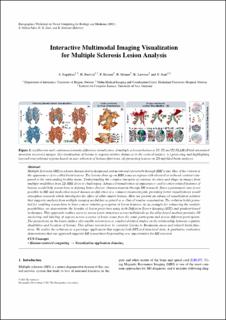| dc.contributor.author | Sugathan, Sherin | |
| dc.contributor.author | Bartsch, Hauke | |
| dc.contributor.author | Riemer, Frank | |
| dc.contributor.author | Grüner, Eli Renate | |
| dc.contributor.author | Lawonn, Kai | |
| dc.contributor.author | Smit, Noeska Natasja | |
| dc.date.accessioned | 2021-11-01T13:13:16Z | |
| dc.date.available | 2021-11-01T13:13:16Z | |
| dc.date.created | 2021-10-10T14:09:23Z | |
| dc.date.issued | 2021 | |
| dc.identifier.isbn | 978-3-03868-140-3 | |
| dc.identifier.issn | 2070-5778 | |
| dc.identifier.uri | https://hdl.handle.net/11250/2826911 | |
| dc.description.abstract | Multiple Sclerosis (MS) is a brain disease that is diagnosed and monitored extensively through MRI scans. One of the criteria is the appearance of so-called brain lesions. The lesions show up on MRI scans as regions with elevated or reduced contrast compared to the surrounding healthy tissue. Understanding the complex interplay of contrast, location and shape in images from multiple modalities from 2D MRI slices is challenging. Advanced visualization of appearance- and location-related features of lesions would help researchers in defining better disease characterization through MS research. Since a permanent cure is not possible in MS and medication-based disease modification is a common treatment path, providing better visualizations would strengthen research which investigates the effect of white matter lesions. Here we present an advanced visualization solution that supports analysis from multiple imaging modalities acquired in a clinical routine examination. The solution holds potential for enabling researchers to have a more intuitive perception of lesion features. As an example for enhancing the analytic possibilities, we demonstrate the benefits of lesion projection using both Diffusion Tensor Imaging (DTI) and gradient-based techniques. This approach enables users to assess brain structures across individuals as the atlas-based analysis provides 3D anchoring and labeling of regions across a series of brain scans from the same participant and across different participants. The projections on the brain surface also enable researchers to conduct detailed studies on the relationship between cognitive disabilities and location of lesions. This allows researchers to correlate lesions to Brodmann areas and related brain functions. We realize the solutions in a prototype application that supports both DTI and structural data. A qualitative evaluation demonstrates that our approach supports MS researchers by providing new opportunities for MS research. | en_US |
| dc.language.iso | eng | en_US |
| dc.publisher | Eurographics | en_US |
| dc.title | Interactive Multimodal Imaging Visualization for Multiple Sclerosis Lesion Analysis | en_US |
| dc.type | Journal article | en_US |
| dc.type | Peer reviewed | en_US |
| dc.description.version | acceptedVersion | en_US |
| dc.rights.holder | Copyright 2021 The Eurographics Association. | en_US |
| cristin.ispublished | true | |
| cristin.fulltext | postprint | |
| cristin.qualitycode | 1 | |
| dc.identifier.doi | 10.2312/vcbm.20211346 | |
| dc.identifier.cristin | 1944686 | |
| dc.source.journal | Eurographics Workshop on Visual Computing for Biomedicine | en_US |
| dc.source.pagenumber | 65-77 | en_US |
| dc.identifier.citation | Eurographics Workshop on Visual Computing for Biomedicine. 2021, 65-77. | en_US |
| dc.source.volume | 2021 | en_US |
